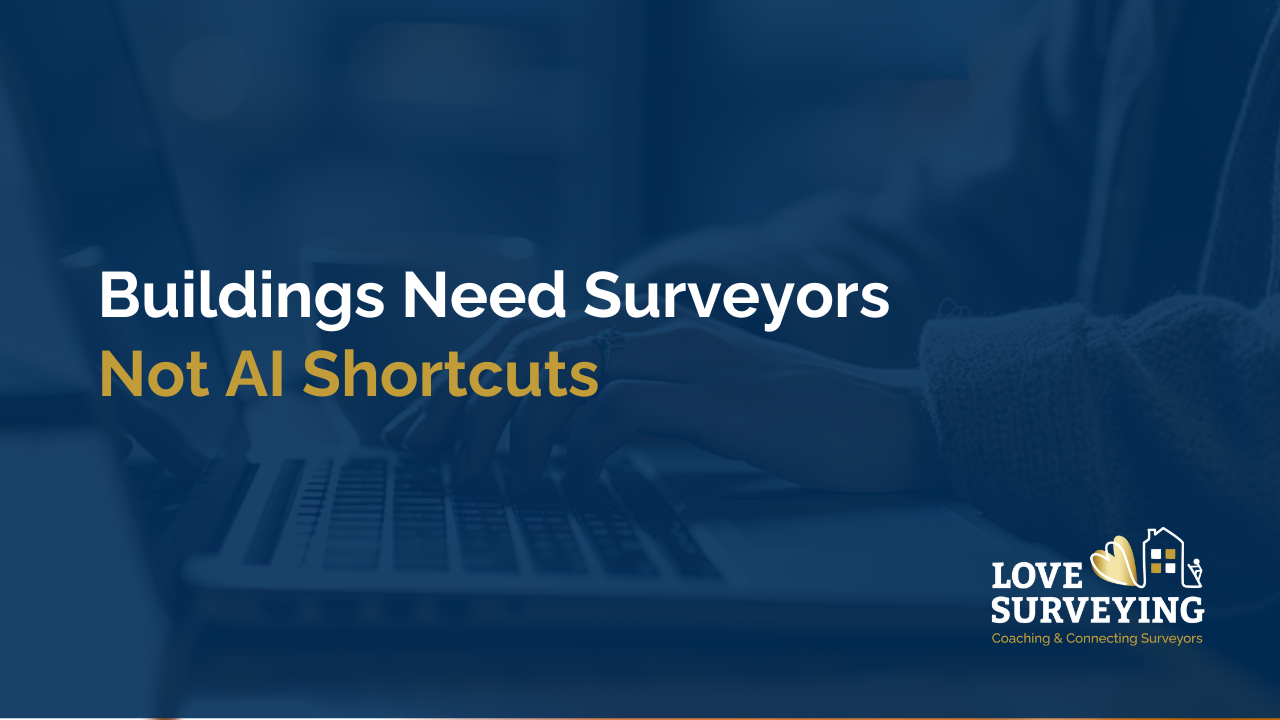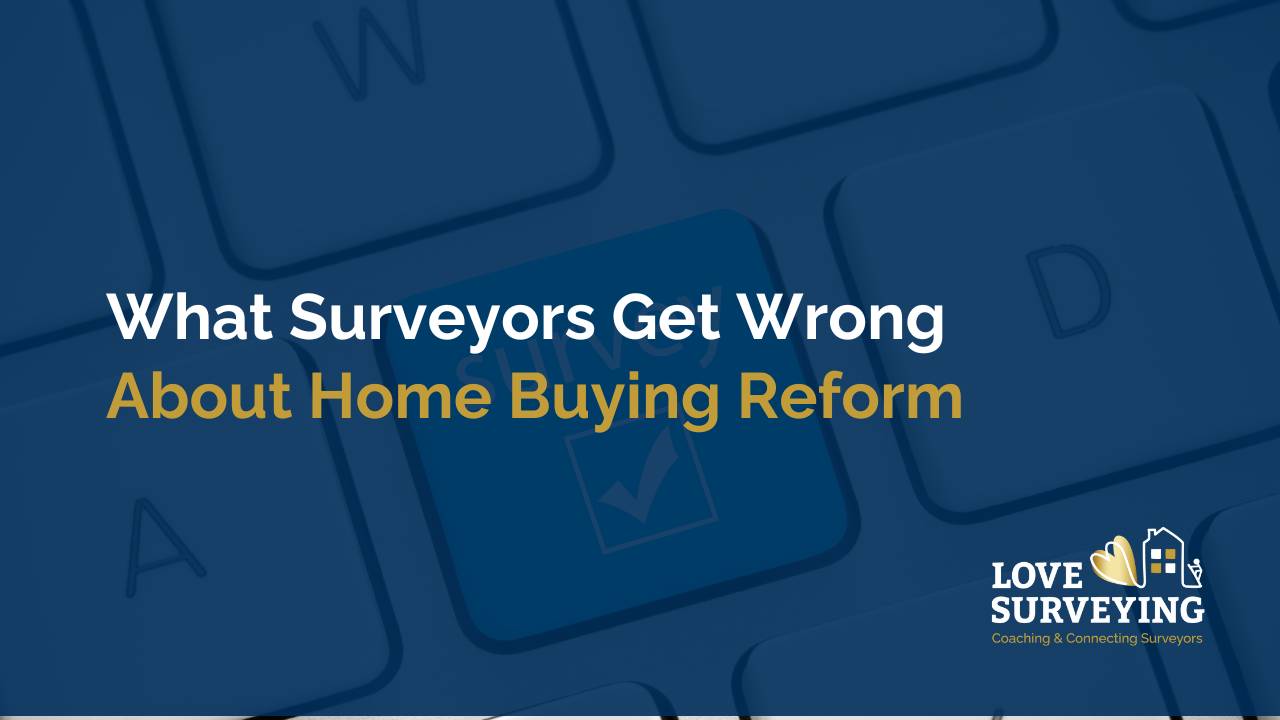Not Every Report Is a Survey - and Why That Matters
Oct 20, 2025
As government and industry look to improve the flow of “material information” in the home buying and selling process, a growing number of reports are being produced - safety compliance visits, damp and mould inspections, contractor assessments, even AI-generated checklists. Then there is the scrape of data which is given a polish and produced as a unique and bespoke report.
They are sometimes called surveys - but not everything that looks like a survey is one. And maybe that’s where the problem starts. These reports can provide useful insight, but we need to be careful about what we call them.
There’s no legal definition of a survey
At present, there is no statutory definition of what a “survey” actually is in UK law - it depends on the context of how it is used.. The term isn’t defined in the Consumer Rights Act, the Building Act, or any other housing legislation. In practice, its meaning depends on the contract between the client and the surveyor, or on a professional standard such as the RICS Home Survey Standard. We need a legal definition - prehaps even protected, and clear, authoritative guidance on when something is, or is not, a survey (and the same goes for a valuation).
Outside of that framework, anyone can describe their report as a “survey,” even if it’s simply a checklist or quotation for works. This lack of legal clarity creates confusion for consumers and professionals alike, blurring the line between a factual inspection and a regulated professional opinion - which is why clear, authoritative guidance or a formal definition is urgently needed.
They are Reports, not Surveys… aren’t they?
Many of these documents are factual records or quotations for works, not professional surveys.
They tell us what has been tested, what passed or failed, and what the estimated cost of repair might be - which can be very helpful for buyers, sellers, and owners planning maintenance.
The priority should always be to consider what is actually useful for consumers: yes, to know what’s wrong, but also what needs fixing, how to do it, and what it might cost.
That distinction matters. Because the moment we start calling these reports “surveys,” we blur the line between factual reporting and professional assessment - and risk misleading consumers about the level of assurance or accountability involved.
This is an issue the industry needs to address collectively, and it may well need legal clarification around where a report ends and professional advice begins.
Making Information Reliable - and Transferable
The answer isn’t to reject these reports; it’s to understand their context. They are useful sources of information and, in many cases, their findings could and should be transferable - provided the information is clear, factual, and the terms of reliance are properly set out.
Surveyors routinely review a wide range of documents - from guarantees to specialist tests - and then use their expertise to form a professional opinion. But that process depends on trust in the underlying data. If the information we receive is unclear, incomplete, or unverifiable, passing it back helps no one.
That’s why any report or information shared as “material information” must be credible, transparent, and capable of being relied upon by another party.
For that to happen, providers must:
- State who the original client is and who else may rely on the findings.
- Confirm their qualifications, insurance, and registration (for example, whether they’re part of a recognised builders’ or professional scheme).
- Declare whether the report includes a quotation for works and what commercial interest exists.
- Define the scope and limitations of the inspection.
When those conditions are met, reports can safely be shared, transferred, and relied upon by others - buyers, surveyors, lenders, and agents alike.
The surveyor’s role is then to take that verified information, place it in context, and provide independent professional judgement on what it means for the client should they proceed with the property purchase. It’s not about repeating someone else’s findings or marketing someone’s homework, but about interpreting them responsibly within a wider picture. It also raises the question of what the surveyor should do if information is found to be incorrect.
If we want information to move with the property, we need to make it reliable enough to do so.
More Data, Same Duty: Why the Site Visit Still Matters
Used well, a broader base of factual information can enhance a surveyor’s work. It can provide context, highlight patterns, and support better advice.
But the site visit should remain non-negotiable. You cannot understand a building fully without being there - seeing how it sits, feels, and functions.
Every home, every client, and every situation is unique. The role of the surveyor is to interpret all available data and tailor advice to that individual property and client.
That’s what makes it a professional service, not a commodity. It’s a consultancy service, not just a report service - and that, for some surveyors, is a significant shift, especially for those who do not currently engage with their clients in that way.
This evolution also challenges surveyors to become clearer in how they explain their value. Clients don’t just need information - they need guidance and reassurance.
A factual report might tell you what is wrong. A surveyor helps you understand why, what it means, and what to do next.
As the home-buying process becomes more data-driven, the surveyor’s greatest strength will be the ability to bring context, judgment, and humanity to that information. The direction of travel is right - more transparency, more data, more informed buyers. But the solution lies in collaboration:
- Clear terminology and legal definitions for reports vs. surveys.
- Shared standards for data reliability and disclosure.
- Better communication with clients about what surveyors really do.
If we can combine high-quality information with independent professional interpretation, we can build a system that is both modern and trusted. That’s the real reform worth striving for.
Not just anyone can become a surveyor - but as the process evolves, we must be clear on the value we bring, and how we adapt to a changing way of buying and selling homes.
Counterpoints, Concerns and Legal Context
Not everyone in the profession will agree with this direction — and that’s understandable. Change brings uncertainty, and surveyors have legitimate concerns about how wider access to data and new types of reports could affect their role and responsibilities.
Some fear this could lead to seller’s surveys by stealth, similar to the Scottish model, where the surveyor is instructed by the seller and the buyer relies on that report. But what’s being discussed here is very different. The aim is not to replace the independent buyer’s survey, but to raise the baseline of factual information that everyone can use. The independence of professional judgement remains central.
Others worry they will be expected to rely on poor-quality or unregulated reports from contractors or technology providers. That’s a valid concern - and it’s exactly why quality assurance, clear disclosure, and agreed standards are essential. No professional should be expected to rely on or interpret data that isn’t credible or verifiable.
Some see this as adding extra responsibility without fair pay. Interpreting third-party data, explaining its limitations, and integrating it into professional advice takes time - and that needs to be reflected in scope and fees. But it also opens an opportunity to move from producing reports to offering consultancy and guidance - work that should be valued more highly.
There’s also a practical question: would a contractor or trader really want to take on extra liability by allowing their report to be relied upon by a buyer? Probably not - at least, not without clear limits. In law, a contractor’s duty of care usually extends only to the client who commissioned them, unless their terms specifically allow reliance by others or a letter of reliance is issued. Most trade reports include disclaimers such as: “This report is confidential and prepared for the client named only. No responsibility is accepted for reliance by others.”
That protects the contractor from liability if the report is later shared — but it also limits how useful that information can be within the home-buying process. If reports are to be included as part of “material information,” transparency and transferability need to be built in. Providers should make their terms of engagement clear, state who may rely on the findings, and confirm whether any guarantees can be transferred.
These concerns are not barriers - they’re reminders that collaboration, clear definitions, and proportionate standards will be key to making reform work for everyone.
Why it matters
The future isn’t about replacing professional judgement with data - it’s about giving professionals better data to make better judgements.
If we want to modernise home buying, we have to build trust into every part of the process: from how data is gathered, to how it’s shared, interpreted, and explained. That means clarity about what a “survey” really is, who can rely on information, and what independence looks like in a digital, data-driven world.
Consumers deserve clarity and confidence. Surveyors deserve professional frameworks that protect and value their expertise. And as an industry, we have a shared opportunity - to design something that truly works for everyone.
Enjoyed this article?
You might also like: Why the Scottish Home Report Doesn't Work for England and Wales
Find it useful? Please share it with friends or colleagues who might benefit.
Want to support my work?
Leave me a quick Google Review or Buy Me a Coffee ☕





